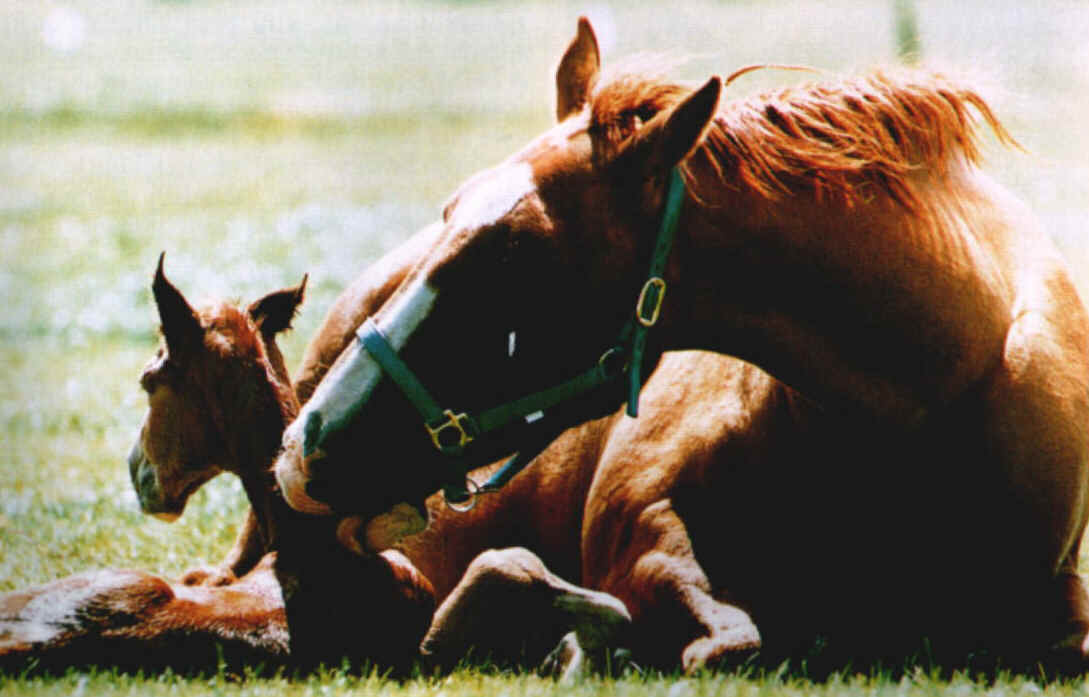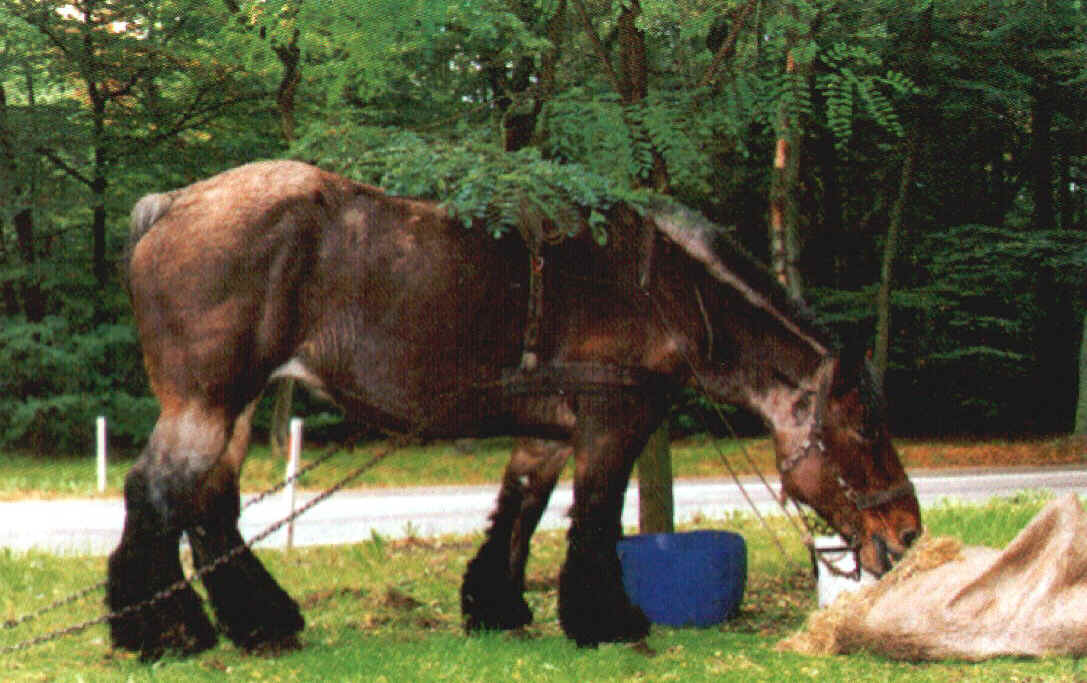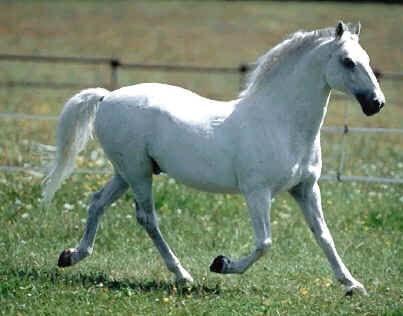



LIPPIZANER
 Famed
breed of riding and show horse, renowned for its exquisite
equestrian ballet performances made famous by the Spanish Riding
School in Vienna, Austria. Lipizzaner stallions are used for the
highest form of dressage (guiding a horse through a series of
complex maneuvers with slight movements of the hands, legs, and
weight of the rider), including breathtaking leaps into the air.
For all its majesty, the Lipizzaner is a small horse, standing
about 153 cm (about 60 in, or 15 hands) high at the withers (the
high part of the back, located between the shoulder blades). The
powerful body is compact, and it has short legs. The back is
long, and the chest is wide and deep. The muscular, arched neck
supports a long head. The Lipizzaner has large, expressive eyes,
small ears, and flared nostrils. Most Lipizzaners are born brown
or black, but lighten in color as they grow older, becoming
almost white by the time they are 10 years old. About 1 in 100 is
colored bay (reddish). Bays are not allowed to breed. The breed
is named for the town of Lipizza, in what was part of the
Austro-Hungarian Empire and is now part of Slovenia, where it
originated in 1580 and is bred to this day. Nine Andalusian
(Spanish) stallions and 24 mares were imported from the Iberian
Peninsula at the direction of Archduke Charles II to produce
horses suitable for the royal courts. In 1738, Archduke Charles
VI established a riding school for nobility, which used the
Lipizzaner. He named it the Spanish Riding School to emphasize
the Lipizzaner\'92s Andalusian blood. The Lipizzaner remained the
horse of royalty until the fall of the Austro-Hungarian Empire at
the end of World War I (1914-1918). American troops evacuated
Lipizzaners from their stables near the end of World War II
(1939-1945) because they were in the path of the advancing Soviet
army. The main breeding stables later were located at Piber,
Austria. Each Lipizzaner stallion is branded with a symbol for
the stallion line of his mother above a letter symbol for his
father's line. Only Lipizzaner stallions perform at the Spanish
Riding School where these horses appear in shows regularly. A
stallion's first four summers are spent grazing in the alpine
pastures above Piber before its training begins. It is trained in
the complicated dressage steps for another four years, and may
perform into its 20s. The Lipizzaner remains the main harness
(cart- and carriage-pulling) horse in Austria, and is a popular
riding horse throughout Eastern Europe. Many Lipizzaners are used
in circuses, and a few still are used for farm work.
Famed
breed of riding and show horse, renowned for its exquisite
equestrian ballet performances made famous by the Spanish Riding
School in Vienna, Austria. Lipizzaner stallions are used for the
highest form of dressage (guiding a horse through a series of
complex maneuvers with slight movements of the hands, legs, and
weight of the rider), including breathtaking leaps into the air.
For all its majesty, the Lipizzaner is a small horse, standing
about 153 cm (about 60 in, or 15 hands) high at the withers (the
high part of the back, located between the shoulder blades). The
powerful body is compact, and it has short legs. The back is
long, and the chest is wide and deep. The muscular, arched neck
supports a long head. The Lipizzaner has large, expressive eyes,
small ears, and flared nostrils. Most Lipizzaners are born brown
or black, but lighten in color as they grow older, becoming
almost white by the time they are 10 years old. About 1 in 100 is
colored bay (reddish). Bays are not allowed to breed. The breed
is named for the town of Lipizza, in what was part of the
Austro-Hungarian Empire and is now part of Slovenia, where it
originated in 1580 and is bred to this day. Nine Andalusian
(Spanish) stallions and 24 mares were imported from the Iberian
Peninsula at the direction of Archduke Charles II to produce
horses suitable for the royal courts. In 1738, Archduke Charles
VI established a riding school for nobility, which used the
Lipizzaner. He named it the Spanish Riding School to emphasize
the Lipizzaner\'92s Andalusian blood. The Lipizzaner remained the
horse of royalty until the fall of the Austro-Hungarian Empire at
the end of World War I (1914-1918). American troops evacuated
Lipizzaners from their stables near the end of World War II
(1939-1945) because they were in the path of the advancing Soviet
army. The main breeding stables later were located at Piber,
Austria. Each Lipizzaner stallion is branded with a symbol for
the stallion line of his mother above a letter symbol for his
father's line. Only Lipizzaner stallions perform at the Spanish
Riding School where these horses appear in shows regularly. A
stallion's first four summers are spent grazing in the alpine
pastures above Piber before its training begins. It is trained in
the complicated dressage steps for another four years, and may
perform into its 20s. The Lipizzaner remains the main harness
(cart- and carriage-pulling) horse in Austria, and is a popular
riding horse throughout Eastern Europe. Many Lipizzaners are used
in circuses, and a few still are used for farm work.
Akhal Teké - Andalusian - Appaloosa - Arabian - Ass - Australian Stock Horse - Bashkir Belgium Heavy Draft horse - Cleveland Bay - Clydesdale - Dutch Warmblood - Gelderlander - Hackney - Holsteiner - Paard (algemeen) - Irish Draught - Lippizaner - Missouri Fox Trotter - Morgan Horse - Mule - Mustang - Oldenburger - Palomino - Percheron - Peruvian Paso - Pinto - Quarter Horse - Selle Francais - Standardbred - Tarpan - Tennessee Walker - Trakehner - Ungulate (onevenhoevigen) - Zebra -